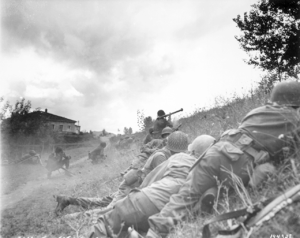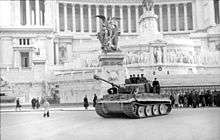Italian campaign (World War II)
The Italian campaign of World War II consisted of Allied and Axis operations in and around Italy, from 1943 to 1945. The Joint Allied Forces Headquarters (AFHQ) was operationally responsible for all Allied land forces in the Mediterranean theatre and it planned and led the invasion of Sicily in July 1943, followed in September by the invasion of the Italian mainland and the campaign in Italy until the surrender of the German Armed Forces in Italy in May 1945.
It is estimated that between September 1943 and April 1945, 60,000–70,000 Allied and 38,805–150,660 German soldiers died in Italy.[28][nb 1] The number of Allied casualties was about 320,000 and the German figure (excluding those involved in the final surrender) was over 330,000.[28][nb 2] Fascist Italy, prior to its collapse, suffered about 200,000 casualties, mostly POWs taken in the invasion of Sicily, including more than 40,000 killed or missing.[30] Over 150,000 Italian civilians died, as did 35,828 anti-fascist partisans and some 35,000 troops of the Italian Social Republic.[31][32][33] On the Western Front of World War II, Italy was the most costly campaign in terms of casualties suffered by infantry forces of both sides, during bitter small-scale fighting around strongpoints at the Winter Line, the Anzio beachhead and the Gothic Line.[34]
The invasion of Sicily in July 1943 led to the collapse of the Fascist Italian regime and the fall of Mussolini, who was deposed and arrested by order of King Victor Emmanuel III on 25 July. The new government signed an armistice with the Allies on 8 September 1943. However, German forces soon took control of northern and central Italy; Mussolini, who was rescued by German paratroopers, established a collaborationist puppet state, the Italian Social Republic (RSI) to administer the German-occupied territory. The Germans, often with Italian fascists, also committed several atrocities against civilians and non-fascist troops. As a result, the Italian Co-Belligerent Army was created to fight against the RSI and its German allies, alongside the large Italian resistance movement, while other Italian troops, loyal to Mussolini, continued to fight alongside the Germans in the National Republican Army. This period is known as the Italian Civil War. The campaign ended when Army Group C surrendered unconditionally to the Allies on May 2, 1945, one week before the formal German Instrument of Surrender. The independent states of San Marino and the Vatican, both surrounded by Italian territory, also suffered damage during the campaign.
Strategic background
Even before the victory in the North African campaign in May 1943, there was disagreement among the Allies on the best strategy to defeat the Axis. The British, especially the prime minister, Winston Churchill, advocated their traditional naval-based peripheral strategy. Even with a large army, but greater naval power, the traditional British answer against a continental enemy was to fight as part of a coalition and mount small peripheral operations designed to gradually weaken the enemy. The United States, with the larger U.S. Army, favoured a more direct method of fighting the main force of the German Army in northwestern Europe. The ability to launch such a campaign depended on first winning the Battle of the Atlantic.
The strategic disagreement was fierce, with the U.S. service chiefs arguing for an invasion of France as early as possible, while their British counterparts advocated a policy centred on operations in the Mediterranean. There was even pressure from some Latin American countries to stage an invasion of Spain, which, under Francisco Franco, was friendly to the Axis nations, although not a participant in the war.[35] The American staff believed that a full-scale invasion of France at the earliest possible time was required to end the war in Europe, and that no operations should be undertaken that might delay that effort. The British argued that the presence of large numbers of troops trained for amphibious landings in the Mediterranean made a limited-scale invasion possible and useful.
Eventually the U.S. and British political leadership reached a compromise in which both would commit most of their forces to an invasion of France in early 1944, but also launch a relatively small-scale Italian campaign. A contributing factor was Franklin D. Roosevelt's desire to keep U.S. troops active in the European theatre during 1943 and his attraction to the idea of eliminating Italy from the war.[36] It was hoped that an invasion might knock Italy out of the conflict,[37] or at least increase the pressure on it and weaken it.[38][39] The elimination of Italy would enable Allied naval forces, principally the Royal Navy, to dominate the Mediterranean Sea, securing the lines of communications with Egypt and thus Asia.[39][40] Italian divisions on occupation and coastal defence duties in the Balkans and France would be withdrawn to defend Italy, while the Germans would have to transfer troops from the Eastern Front to defend Italy and the entire southern coast of France, thus aiding the Soviet Union.[41][42]
Campaign
Invasion of Sicily
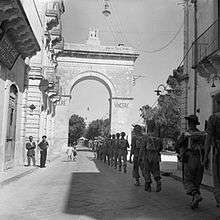
A combined Allied invasion of Sicily began on 10 July 1943 with both amphibious and airborne landings at the Gulf of Gela. The land forces involved were the U.S. Seventh Army, under Lieutenant General George S. Patton, and the British Eighth Army, under General Bernard Montgomery. The original plan contemplated a strong advance by the British northwards along the east coast to Messina, with the Americans in a supporting role along their left flank. When the Eighth Army were held up by stubborn defences in the rugged hills south of Mount Etna, Patton amplified the American role by a wide advance northwest toward Palermo and then directly north to cut the northern coastal road. This was followed by an eastward advance north of Etna towards Messina, supported by a series of amphibious landings on the northern coast that propelled Patton's troops into Messina shortly before the first units of the Eighth Army. The defending German and Italian forces were unable to prevent the Allied capture of the island, but they succeeded in evacuating most of their troops to the mainland, with the last leaving on 17 August 1943. The Allied forces gained experience in opposed amphibious operations, coalition warfare, and large airborne drops.
Invasion of Continental Italy
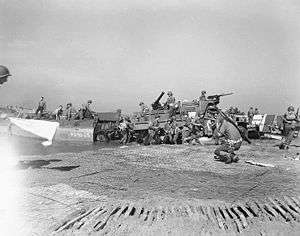
Forces of the British Eighth Army, still under Montgomery, landed in the 'toe' of Italy on 3 September 1943 in Operation Baytown, the day the Italian government agreed to an armistice with the Allies. The armistice was publicly announced on 8 September by two broadcasts, first by General Eisenhower and then by a proclamation by Marshal Badoglio. Although the German forces prepared to defend without Italian assistance, only two of their divisions opposite the Eighth Army and one at Salerno were not tied up disarming the Royal Italian Army.
On 9 September, forces of the U.S. Fifth Army, under Lieutenant General Mark W. Clark, expecting little resistance, landed against heavy German resistance at Salerno in Operation Avalanche; in addition, British forces landed at Taranto in Operation Slapstick, which was almost unopposed. There had been a hope that, with the surrender of the Italian government, the Germans would withdraw to the north, since at the time Adolf Hitler had been persuaded that Southern Italy was strategically unimportant. However, this was not to be; although, for a while, the Eighth Army was able to make relatively easy progress up the eastern coast, capturing the port of Bari and the important airfields around Foggia. Despite none of the northern reserves having been made available to the German 10th Army, it nevertheless came close to repelling the Salerno landing. The main Allied effort in the west initially centred on the port of Naples: that city was selected because it was the northernmost port that could receive air cover by fighter planes flying from Sicily.
As the Allies advanced, they encountered increasingly difficult terrain: the Apennine Mountains form a spine along the Italian peninsula offset somewhat to the east. In the most mountainous areas of Abruzzo, more than half the width of the peninsula comprises crests and peaks over 3,000 feet (910 m) that are relatively easy to defend; and the spurs and re-entrants to the spine confronted the Allies with a succession of ridges and rivers across their line of advance. The rivers were subject to sudden and unexpected flooding, which had the potential to thwart the Allied commanders' plans.[43]
Allied advance on Rome

In early October 1943, Hitler was persuaded by his Army Group Commander in Southern Italy, Field Marshal Albert Kesselring, that the defence of Italy should be conducted as far away from Germany as possible. This would make the most of the natural defensive geography of Central Italy, whilst denying the Allies the easy capture of a succession of airfields, each one being ever closer to Germany. Hitler was also convinced that yielding southern Italy would provide the Allies with a springboard for an invasion of the Balkans, with its vital resources of oil, bauxite and copper.[44]
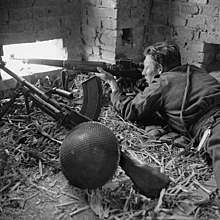
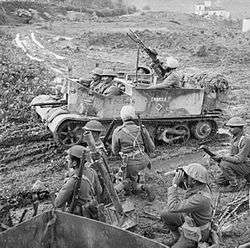
Kesselring was given command of the whole of Italy and immediately ordered the preparation of a series of defensive lines across Italy, south of Rome. Two lines, the Volturno and the Barbara, were used to delay the Allied advance so as to buy time to prepare the most formidable defensive positions, which formed the Winter Line – the collective name for the Gustav Line and two associated defensive lines on the west of the Apennine Mountains, the Bernhardt and Hitler lines (the latter had been renamed the Senger Line by 23 May 1944).[45]
_-_1946-05-16_-_J%C3%B3zef_Gawlina_in_Casarano.jpg)
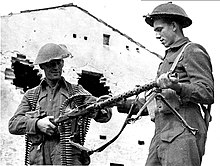
The Winter Line proved a major obstacle to the Allies at the end of 1943, halting the Fifth Army's advance on the western side of Italy. Although the Gustav Line was penetrated on the Eighth Army's Adriatic front, and Ortona was liberated with heavy casualties to Canadian troops, the blizzards, drifting snow and zero visibility at the end of December caused the advance to grind to a halt. The Allies' focus then turned to the western front, where an attack through the Liri valley was considered to have the best chance of a breakthrough towards the Italian capital. Landings behind the line at Anzio during Operation Shingle, advocated by the British Prime Minister, Winston Churchill, were intended to destabilise the German Gustav line defences, but the early thrust inland to cut off the German defences did not occur because of disagreements that the American commander, Major General John P. Lucas, had with the battle plan, and his insistence that his forces were not large enough to accomplish their mission. Lucas entrenched his forces, during which time Field Marshal Kesselring assembled sufficient forces to form a ring around the beachhead. After a month of hard fighting, Lucas was replaced by Major General Lucian Truscott, who eventually broke out in May.
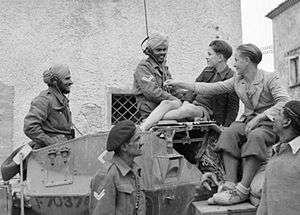
It took four major offensives between January and May 1944 before the line was eventually broken by a combined assault of the Fifth and Eighth Armies (including British, American, French, Polish, and Canadian corps) concentrated along a twenty-mile front between Monte Cassino and the western seaboard. In a concurrent action, American General Mark Clark was ordered to break out of the stagnant position at Anzio and cash in on the opportunity to cut off and destroy a large part of the German 10th Army retreating from the Gustav Line between them and the Canadians. But this opportunity was lost on the brink of success, when Clark disobeyed his orders and sent his U.S. forces to enter the vacant Rome instead.[46] Rome had been declared an open city by the German Army so no resistance was encountered.
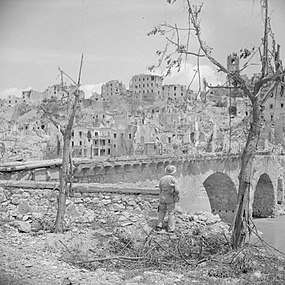
The American forces took possession of Rome on 4 June 1944.[47] The German Tenth Army were allowed to get away and, in the next few weeks, may have been responsible for doubling the Allied casualties in the next few months. Clark was hailed as a hero in the United States though postwar assessments have been critical of his command decisions.
Allied advance into Northern Italy

After the capture of Rome, and the Allied invasion of Normandy in June, the U.S. VI Corps and the French Expeditionary Corps (CEF), which together amounted to seven divisions, were pulled out of Italy during the summer of 1944 to participate in Operation Dragoon, codename for the Allied invasion of Southern France. The sudden removal of these experienced units from the Italian front was only partially compensated for by the gradual arrival of three divisions, the Brazilian 1st Infantry Division, the U.S. 92nd Infantry Division, both in the second half of 1944, and the U.S. 10th Mountain Division in January 1945.[47]
In the period from June to August 1944, the Allies advanced beyond Rome, taking Florence and closing up on the Gothic Line.[48] This last major defensive line ran from the coast some 30 miles (48 km) north of Pisa, along the jagged Apennine Mountains chain between Florence and Bologna to the Adriatic coast, just south of Rimini. In order to shorten the Allied lines of communication for the advance into Northern Italy, the Polish II Corps advanced towards the port of Ancona and, after a month-long battle, succeeded in capturing it on 18 July.
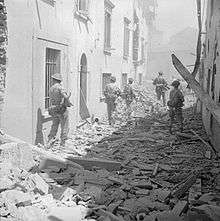
During Operation Olive, which commenced on 25 August, the Gothic Line defences were penetrated on both the Fifth and Eighth Army fronts; but, there was no decisive breakthrough. Churchill, the British Prime Minister, had hoped that a major advance in late 1944 would open the way for the Allied armies to advance northeast through the "Ljubljana Gap" (the area between Venice and Vienna, which is today's Slovenia) to Vienna and Hungary to forestall the Red Army from advancing into Eastern Europe. Churchill's proposal had been strongly opposed by the U.S. Chiefs of Staff as, despite its importance to British postwar interests in the region, they did not believe that it aligned with overall Allied war priorities.[47]
In October, Lieutenant General Sir Richard McCreery succeeded Lieutenant General Sir Oliver Leese as the commander of the Eighth Army. In December, Lieutenant General Mark Clark, the Fifth Army commander, was appointed to command the 15th Army Group, thereby succeeding the British General Sir Harold Alexander as commander of all Allied ground troops in Italy; Alexander succeeded Field Marshal Sir Henry Wilson as the Supreme Allied Commander in the Mediterranean Theatre. Clark was succeeded in command of the Fifth Army by Lieutenant General Lucian K. Truscott, Jr.. In the winter and spring of 1944–45, extensive partisan activity in Northern Italy took place. As there were two Italian governments during this period, (one on each side of the war), the struggle took on some characteristics of a civil war.
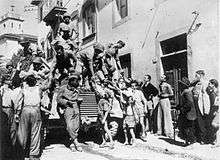
The poor winter weather, which made armoured manoeuvre and the exploitation of overwhelming air superiority impossible, coupled with the massive losses suffered to its ranks during the autumn fighting,[49][50] the need to transfer some British troops to Greece (as well as the need to withdraw the British 5th Infantry Division and I Canadian Corps to northwestern Europe) made it impractical for the Allies to continue their offensive in early 1945. Instead, the Allies adopted a strategy of "offensive defence" while preparing for a final attack when better weather and ground conditions arrived in the spring.
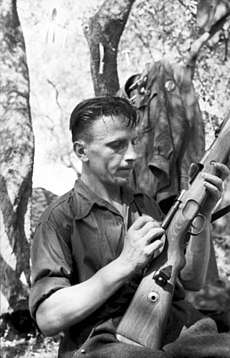
In late February-early March 1945, Operation Encore saw elements of the U.S. IV Corps (1st Brazilian Division and the newly arrived U.S. 10th Mountain Division) battling forward across minefields in the Apennines to align their front with that of the U.S. II Corps on their right.[51] They pushed the German defenders from the commanding high point of Monte Castello and the adjacent Monte Belvedere and Castelnuovo, depriving them of artillery positions that had been commanding the approaches to Bologna since the narrowly failed Allied attempt to take the city in the autumn.[52][53][54] Meanwhile, damage to other transport infrastructure forced Axis forces to use sea, canal and river routes for re-supply, leading to Operation Bowler against shipping in Venice harbour on 21 March 1945.
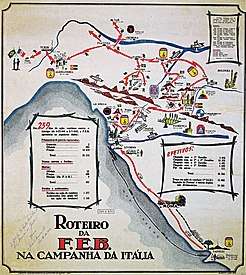
The Allies' final offensive commenced with massive aerial and artillery bombardments on 9 April 1945.[55] The Allies had 1,500,000 men and women deployed in Italy in April 1945.[9] The Axis on 7 April had 599,404 troops of which 439,224 were Germans and 160,180 were Italians.[9] By 18 April, Eighth Army forces in the east had broken through the Argenta Gap and sent armour racing forward in an encircling move to meet the U.S. IV Corps advancing from the Apennines in Central Italy and to trap the remaining defenders of Bologna.[47] On 21 April, Bologna was entered by the 3rd Carpathian Division, the Italian Friuli Group (both from the Eighth Army) and the U.S. 34th Infantry Division (from the Fifth Army).[56] The U.S. 10th Mountain Division, which had bypassed Bologna, reached the River Po on 22 April; the 8th Indian Infantry Division, on the Eighth Army front, reached the river on 23 April.[57]
By 25 April, the Italian Partisans' Committee of Liberation declared a general uprising,[58] and on the same day, having crossed the Po on the right flank, forces of the Eighth Army advanced north-northeast towards Venice and Trieste. On the front of the U.S. Fifth Army, divisions drove north toward Austria and northwest to Milan. On the Fifth Army's left flank, the U.S. 92nd Infantry Division (the "Buffalo Soldiers Division") went along the coast to Genoa. A rapid advance towards Turin by the Brazilian division on their right took the German–Italian Army of Liguria by surprise, causing its collapse.[53]
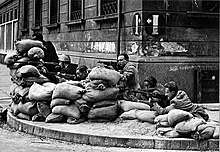
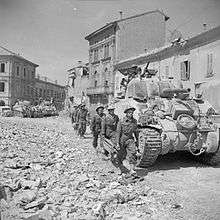
As April 1945 came to an end, the German Army Group C, retreating on all fronts and having lost most of its fighting strength, was left with little option but surrender.[53] General Heinrich von Vietinghoff, who had taken command of Army Group C after Albert Kesselring had been transferred to become Commander-in-Chief of the Western Front (OB West) in March 1945, signed the instrument of surrender on behalf of the German armies in Italy on 29 April, formally bringing hostilities to an end on 2 May 1945.[59]
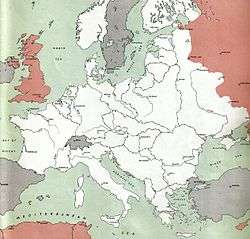 1 July 1943 |
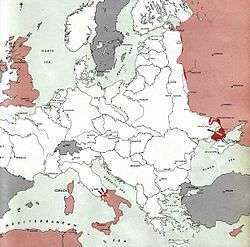 1 November 1943 |
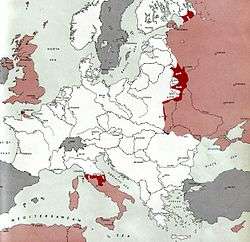 1 July 1944 |
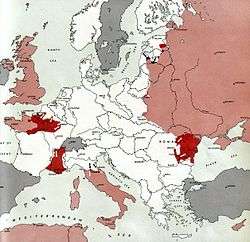 1 September 1944 |
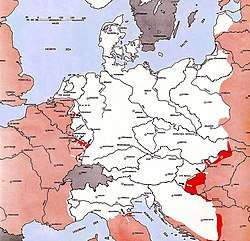 1 December 1944 |
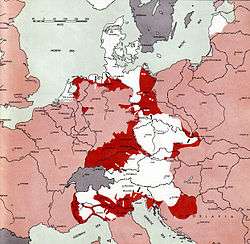 1 May 1945 |
See also
- Military history of Italy during World War II
- Italian Co-Belligerent Army
- Italian Co-Belligerent Navy
- Italian Co-Belligerent Air Force
- Italian Social Republic
- Italian resistance movement
- Italian Civil War
Notes
- Footnotes
- In May 1944, eleven out of the total twelve battalion strong Protectorate Government Army (5,002 soldiers, including 272 officers) were moved to northern Italy to support German military operations there.[4][5] Responsibilities were limited to a passive role in the construction of fortifications and field positions.[6] Approximately 600 soldiers deserted to the Italian partisans, due in part to the effects of the propaganda campaign "Operation Sauerkraut" of the United States' Office of Strategic Services.[7]
- Ellis provides the following information on Allied losses for the campaign, but includes no dates. American: 29,560 killed and missing, 82,180 wounded, 7,410 captured; British: 89,440 killed, wounded, or missing, no information is provided on those captured; Indian: 4,720 killed or missing, 17,310 wounded, and 46 captured; Canadian: 5,400 killed or missing, 19,490 wounded, and 1,000 captured; Pole: 2,460 killed or missing, 8,460 wounded, no information is provided for those captured; South African: 710 killed or missing, 2,670 wounded, and 160 captured; French: 8,600 killed or missing, 23,510 wounded, no information is provided on those captured; Brazilian: 510 killed or missing, 1,900 wounded, no information is provided on those captured; New Zealand: no information is provided for the campaign.[14]
- United States: 114,000 casualties;[15] British Commonwealth: 198,000 casualties[16] Total Allied casualties: 59,151 killed, 30,849 missing and 230,000 wounded.[17]
- American: 119,279 casualties; Brazilian: 2,211 casualties; British: 89,436 casualties; British Colonial troops: 448 casualties; Canadian: 25,889 casualties; French: 27,625 casualties; Greeks: 452 casualties; Indian, 19,373 casualties; Italian: 4,729 casualties; New Zealand; 8,668 casualties; Polish: 11,217 casualties; South African: 4,168 casualties.[18]
- Between 1 September 1943 and 10 May 1944: 87,579 casualties. Between 11 May 1944 and 31 January 1945: 194,330 casualties. Between February and March 1945: 13,741 casualties. British estimates for 1–22 April 1945: 41,000 casualties. This total excludes Axis forces that surrendered at the end of the campaign[22]
- Ellis states that from various sources, between September 1939 and 31 December 1944, the German Armed Forces (including the Waffen SS and foreign volunteers) lost 59,940 killed, 163,600 wounded, and 357,090 captured within Italy.[14]
- Overmans lists the total death toll of German troops in Italy (including Sicily) as 150,660.[23]The US military estimated 91,000 German dead in the Italian campaign, thereof 5,000 in Sicily and 86,000 on the Italian mainland, and 364,189 captured prior to the surrender of Army Group C, thereof 7,100 in Sicily and 357,086 on the Italian mainland[24][25] Including 10 killed, 15 wounded and 800 defected from the Protectorate of Bohemia and Moravia
- In Alexander's Generals Blaxland quotes 59,151 Allied deaths between 3 September 1943 and 2 May 1945 as recorded at AFHQ and gives the breakdown between 20 nationalities: United States 20,442; United Kingdom, 18,737; France, Morocco, Algeria, Tunisia, Senegal and Belgium 5,241; Canada, 4,798; India, Pakistan, Nepal 4,078; Poland 2,028; New Zealand 1,688; Italy (excluding irregulars) 917; South Africa 800; Brazil 275; Greece 115; Jewish volunteers from the British Mandate in Palestine 32. In addition 35 soldiers were killed by enemy action while serving with pioneer units from Botswana, Lesotho, Swaziland, Seychelles, Mauritius, Sri Lanka, Lebanon, Cyprus and the West Indies[17]
- Field Marshal Sir Harold Alexander after the war used a figure of 312,000[29] but later historians generally arrive at a slightly higher figure.
- Citations
- Mandel, Ernest (1986). The Meaning of the Second World War. Verso. p. 132.: "[The campaign's] tactical and military successes needed to be put at the servce of a broader strategic...purpose. Here the failure was almost total. What initially looked like a rapid thrust into the heartland of Europe became a long-drawn-out, painful and costly war of position and attrition...lasting nearly 20 months."
- Gaujac, p. 68
- Royal Australian Navy – the corvettes/minesweepers HMAS Cairns, Cessnock, HMAS Gawler, HMAS Geraldton, HMAS Ipswich, HMAS Lismore, HMAS Maryborough, and HMAS Wollongong.
Royal Australian Air Force – No. 3 Squadron RAAF (fighters), No. 450 Squadron RAAF (fighters), No. 458 Squadron RAAF (maritime patrol), and No. 462 Squadron RAAF (heavy bombers).
Sources: RAN, n.d., Sicily 1943 and Australian War Memorial, n.d., Sicily 1943 (23 September 2018). - "History". hrad.army.cz. Army of the Czech Republic. Retrieved October 27, 2017.
- Thomas, Nigel (2012). The German Army 1939–45 (5): Western Front 1943–45. New York: Bloomsbury. p. 11. ISBN 178200243X.
- Littlejohn, David (1985). Foreign Legions Of The Third Reich. San Jose: Bender Publishing. p. 22. ISBN 9780912138220.
- "A Look Back … Barbara Lauwers: Deceiving the Enemy". cia.gov. Central Intelligence Agency. Retrieved October 25, 2017.
- Frieser 2007, p. 1151.
- Frieser 2007, p. 1158.
- Jackson, p. 230
- Frieser 2007, p. 1156.
- Frieser 2007, p. 1129.
- Shaw, p. 120.
- Ellis, p. 255
- "European Theater". Worldwar2history.info. Retrieved 2011-07-28.
- "The Italian Campaign". Webcitation.org. Archived from the original on October 26, 2009. Retrieved 2011-07-28.
- Blaxland (1979), p. 11
- Jackson, p. 335
- Zaloga 2006, p. 44.
- Ufficio storico dello Stato Maggiore dell'Esercito (USSME) (1993). Le operazioni in Sicilia e in Calabria. Rome. pp. 400–401.
- Hosch 2009, page 122.
- Jackson, p. 400
- Rüdiger Overmans, Deutsche militärische Verluste im Zweiten Weltkrieg. Oldenbourg 2000. ISBN 3-486-56531-1, P. 336 and P.174.
- George C Marshall, Biennial reports of the Chief of Staff of the United States Army to the Secretary of War : 1 July 1939-30 June 1945. Washington, DC : Center of Military History, 1996. Page 202.
- Frieser 2007, p. 1162.
- Atkinson, Rick. "The Guns at Last Light: The War in Western Europe, 1944-1945." Picador; Volume Three of The Liberation Trilogy. May, 2014. Page 616: "The surrender of nearly one million men from Army Group C, effective at noon on May 2, brought to an end the Mediterranean struggle that had begun five years earlier."
- Don Caldwell. "Luftwaffe Aircraft Losses By Theater, September 1943-October 1944". The Air Force Historical Foundation. Retrieved March 1, 2016. 4,468 operational losses are given from the brief period of September 1943 to October 1944 alone.
- Frieser 2007, p. 1,162.
- Blaxland, p. 284.
- Le Operazioni in Sicilia e in Calabria (Luglio-Settembre 1943), Alberto Santoni, p.401, Stato maggiore dell'Esercito, Ufficio storico, 1989
- Updated studies (2010) by the Ufficio dell'Albo d'Oro of the Italian Ministry of Defence, p. 4
- Giuseppe Fioravanzo, La Marina dall'8 settembre 1943 alla fine del conflitto, p. 433. In 2010, the Ufficio dell'Albo d'Oro of the Italian Ministry of Defence recorded 15,197 Italian partisans killed; however, the Ufficio dell'Albo d'Oro only considered as partisans the members of the Italian Resistance who were civilians before joining the partisans, whereas partisans who were formerly members of the Italian armed forces (more than half those killed) were considered as members of their armed force of origin
- In 2010, the Ufficio dell'Albo d'Oro recorded 13,021 RSI soldiers killed; however, the Ufficio dell'Albo d'Oro excludes from its lists of the fallen the individuals who committed war crimes. In the context of the RSI, where numerous war crimes were committed during the Nazi security warfare, and many individuals were therefore involved in such crimes (especially GNR and Black Brigades personnel), this influences negatively the casualty count, under a statistical point of view. The "RSI Historical Foundation" (Fondazione RSI Istituto Storico) has drafted a list that lists the names of some 35,000 RSI military personnel killed in action or executed during and immediately after World War II (including the "revenge killings" that occurred at the end of the hostilities and in their immediate aftermath), including some 13,500 members of the Guardia Nazionale Repubblicana and Milizia Difesa Territoriale, 6,200 members of the Black Brigades, 2,800 Aeronautica Nazionale Repubblicana personnel, 1,000 Marina Nazionale Repubblicana personnel, 1,900 X MAS personnel, 800 soldiers of the "Monterosa" Division, 470 soldiers of the "Italia" Division, 1,500 soldiers of the "San Marco" Division, 300 soldiers of the "Littorio" Division, 350 soldiers of the "Tagliamento" Alpini Regiment, 730 soldiers of the 3rd and 8th Bersaglieri regiments, 4,000 troops of miscellaneous units of the Esercito Nazionale Repubblicano (excluding the aabove-mentioned Divisions and Alpini and Bersaglieri Regiments), 300 members of the Legione Autonoma Mobile "Ettore Muti", 200 members of the Raggruppamento Anti Partigiani, 550 members of the Italian SS, and 170 members of the Cacciatori degli Appennini Regiment.
- Keegan, John "The Second World War" Penguin Books 2005 ISBN 0143035738 p.368
- "Batista's Boost", TIME, January 18, 1943, Retrieved March 2, 2010
- Carver, pp4 & 59
- Blumenson 1969, p. 7.
- Weinberg 1994, pp. 588 & 591.
- Liddell Hart 1970, p. 457.
- Keegan 2005, p. 287.
- Weinberg 1994, p. 591.
- Churchill 1959, p. 669.
- Phillips (1957), p. 20
- Orgill, The Gothic Line, p5
- Carver, p. 195
- Katz, The Battle for Rome
- Clark, Calculated Risk
- Video: Allies Liberate Florence etc. Universal Newsreel. 1944. Retrieved February 21, 2012.
- Keegan, p367
- R.Brooks, The War North of Rome, Chps XIX-XX spec.p254
- Brooks 2003, Chapters XX to XXII
- Moraes, "The Brazilian Expeditionary Force By Its Commander" Chapter V (The IV Corps Offensive); Sections Monte Castello & Castelnuovo
- Bohmler, Rudolf, Monte Cassino, Chapter XI
- Clark, (2007) [1950], p.608 View on Google Books
- Blaxland, pp. 254–255
- Blaxland, p.271
- Blaxland, pp. 272–273
- Blaxland, p.275
- Blaxland, p. 277
References
- Blaxland, Gregory (1979). Alexander's Generals (the Italian Campaign 1944–1945). London: William Kimber. ISBN 0-7183-0386-5.
- Blumenson, Martin (1969). Salerno to Cassino. United States Army in World War II, Mediterranean Theater of Operations. Volume 3. Washington, D.C.: Office of the Chief of Military History, U.S. Army. OCLC 22107.
- Bohmler, Rudolf (1964). Monte Cassino: a German View. Cassell. ASIN B000MMKAYM.
- Brooks, Thomas R. (2003). The War North of Rome (June 1944 – May 1945). Da Capo Press. ISBN 978-0-306-81256-9.
- Carver, Field Marshal Lord (2001). The Imperial War Museum Book of the War in Italy 1943–1945. London: Sidgwick & Jackson. ISBN 0-330-48230-0.
- Churchill, Winston (2002) [1959]. The Second World War. London: Pimlico. ISBN 0712667024.
- Clark, Mark (2007) [1950]. Calculated Risk. New York: Enigma Books. ISBN 978-1-929631-59-9.
- D'Este, Carlo (1990). World War II in the Mediterranean (1942–1945 Major Battles and Campaigns). Algonquin Books. ISBN 978-0-945575-04-7.
- Ellis, John (1993). The World War II Databook: The Essential Facts and Figures for all the combatants. BCA. ISBN 978-1-85410-254-6.
- Frieser, Karl-Heinz; Schmider, Klaus; Schönherr, Klaus; Schreiber, Gerhard; Ungváry, Kristián; Wegner, Bernd (2007). Die Ostfront 1943/44 – Der Krieg im Osten und an den Nebenfronten [The Eastern Front 1943–1944: The War in the East and on the Neighbouring Fronts]. Das Deutsche Reich und der Zweite Weltkrieg [Germany and the Second World War] (in German). VIII. München: Deutsche Verlags-Anstalt. ISBN 978-3-421-06235-2.
- Harpur, Brian (1981). The Impossible Victory. Hippocrene Books. ISBN 0-88254-518-3.
- Hosch, William L. (2009). World War II: People, Politics, and Power. New York: Britannica Educational Publishing/The Rosen Publishing Group. ISBN 1-61530-046-5.
- Jackson, General W.G.F. & with Gleave, Group Captain T.P. (2004) [1st. pub. HMSO 1988]. Butler, J.R.M. (ed.). The Mediterranean and Middle East, Volume VI: Part III – November 1944 to May 1945. History of the Second World War United Kingdom Military Series. Uckfield, UK: Naval & Military Press. ISBN 1-84574-072-6.
- Katz, Robert (2003). The Battle for Rome. Simon & Schuster. ISBN 978-0-7432-1642-5.
- Keegan, John (2005) [1989]. The Second World War. Penguin. ISBN 978-0-14-303573-2.
- Liddell Hart, Basil (1992) [1970]. History of the Second World War. London: Papermac. ISBN 0333582624.
- Moraes, Mascarenhas (1966). The Brazilian Expeditionary Force By Its Commander. US Government Printing Office. ASIN: B000PIBXCG.
- Montemaggi, Amedeo (2002). LINEA GOTICA 1944. La battaglia di Rimini e lo sbarco in Grecia decisivi per l'Europa sud-orientale e il Mediterraneo. Rimini: Museo dell'Aviazione.
- Montemaggi, Amedeo (2006). LINEA GOTICA 1944: scontro di civiltà. Rimini: Museo dell'Aviazione.
- Montemaggi, Amedeo (2008). CLAUSEWITZ SULLA LINEA GOTICA. Imola: Angelini Editore.
- Montemaggi, Amedeo (2010). ITINERARI DELLA LINEA GOTICA 1944. Guida storico iconografica ai campi di battaglia. Rimini: Museo dell'Aviazione.
- Orgill, Douglas (1967). The Gothic Line (The Autumn Campaign in Italy 1944). London: Heinemann.
- Weinberg, Gerhard L. (1994). A World at Arms: A Global History of World War II. Cambridge: Cambridge University Press. ISBN 9780521443173.
- Zaloga, Steve (2006). US Armored Units in the North African and Italian Campaigns 1942-45. Osprey. ISBN 978 1 84176 966 0.CS1 maint: ref=harv (link)
Further reading
- Mavrogordato, Ralph S. (2000) [1960]. "Chapter 12: Hitler's Decision on the Defense of Italy". In Kent Roberts Greenfield (ed.). Command Decisions. United States Army Center of Military History. CMH Pub 70-7.
- Matthews, Sidney T. (2000) [1960]. "Chapter 14: General Clark's Decision to Drive to Rome". In Kent Roberts Greenfield (ed.). Command Decisions. United States Army Center of Military History. CMH Pub 70-7.
- Brown, Shaun R. G. (1986). The Loyal Edmonton Regiment at War, 1943–1945 (MA, Wilfrid Laurier University, 1984). Ottawa: National Library of Canada. ISBN 978-0-31519-038-2. Retrieved 4 March 2016.
External links
| Wikimedia Commons has media related to Italian Campaign (World War II). |
- "Gothic Line". Retrieved 2011-07-03.
- Winter Line Stories Original stories from the front lines of the Italian campaign by US Army Liaison Officer Major Ralph R. Hotchkiss
- World War II
- Ortona and the Italian campaign – 65th Anniversary
- Canadians in Italy, 1943–1945 Media, photos and information on Canadians in the Italian theatre.
- Brazilian WWII Veterans website (in Portuguese)
- Brazilian Expeditionary Force Website (in Portuguese) with histories, biographies, photos, and videos on the Italian campaign.
- New Zealand Official War History Italy volume I: From The Sangro to Cassino, Italy Volume II: From Cassino to Trieste
- Memoirs of Lt-Col Donald, NZEF (Italy, Chapters 8–15)
- Dal Volturno a Cassino, website (in Italian) covering the autumn /winter of 1943 – 44
- World War II propaganda leaflets – use in Italy: A website about airdropped, artillery-delivered or rocket-fired propaganda leaflets. Italian campaign.
- BBC's flash video of the Italian campaign
- Canadian Newspapers and the Second World War – The Sicilian and Italian Campaigns, 1943–1945
- Liberatori: A website on the Po river breakout and the liberation of the small town of Cornuda.
- Royal Engineers Museum Royal Engineers and Second World War (Italian Campaign)
- CBC Digital Archives – The Italian Campaign
- (in Italian) La Città Invisibile Collection of signs, stories and memories during the Gothic Line age.
- (in Italian) Italian Partisan Collection of stories and memories from Italian partisan.
- Italy Volume I, The Sangro to Cassino the New Zealand Official War History
- Italy Volume II, From Cassino to Trieste the New Zealand Official War History
